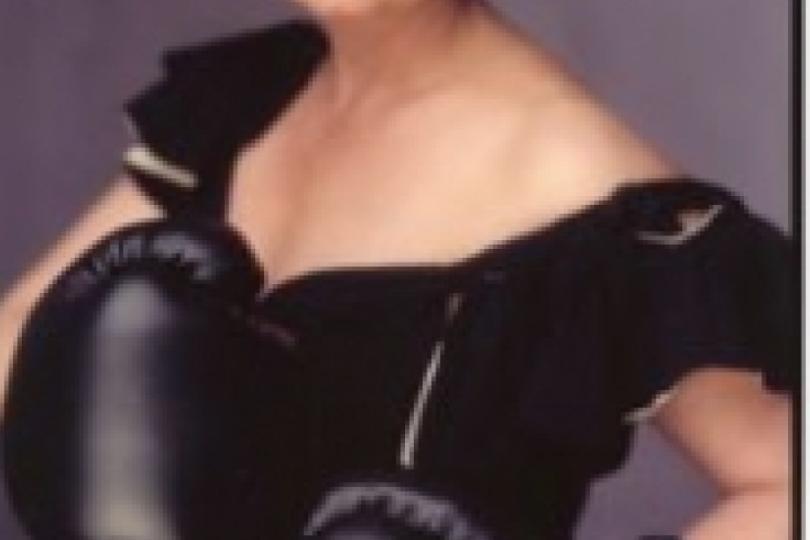Choreographer and critic
Editorial

In 1980, while working as a museum guard during the Walker Art Center’s Picasso show, I became curious about a formal, rather formidable young woman staffing the entrance desk. “That’s Laurie Van Wieren,” someone told me, in whispery aside. “She’s a choreographer.” I was taking dance classes at the University of Minnesota and Ozone at the time; the idea of working as a dance critic or arts journalistic was barely within my scope of reference. Laurie, I later learned, had moved to Minneapolis in 1975 after studying performance art, printmaking and avant-garde film (the latter with Stan Brakhage, no less) at the Art Institute of Chicago. In Minneapolis, she studied with Nancy Hauser and Contactworks, and was preparing for her own performance at the Walker while working there.
Through the decades, we’ve become colleagues and friends. But we’d never talked about the performer-critic relationship we’ve navigated as our careers (Laurie’s as a choreographer; mine as a dance critic) developed and paralleled each other. Last spring, she mounted the first component—“Who Made These Videotapes?”—in a retrospective of her 30-year oeuvre. The performance, at Studio 260 in the Ivy Building for the Arts in Minneapolis, included time to watch, study and ponder such movement pieces/character studies/dance-theater works as “Weak in the Knees,” “Resort” and “Struggle with an Angel.”
She choreographed these pieces about the time I was starting to write dance criticism. So to see them on videotape triggered all sorts of memories: nostalgic, bittersweet, humorous, startling, revelatory and recollective. I asked Laurie if she’d be willing to talk over her work and my writing about it. I found my “LVW” manila folder and we sat down with some green tea. Here are excerpts from our conversation.
CLF: Laurie, the earliest program in my folder is from your 1988 performance with your company, the B-Specifics, at the Ordway McKnight Theatre in St. Paul. I have the program and the press release, but no notes; which means I was actively seeing dance at that point, and writing about it—I believe I was working at the Minnesota Daily then, which is where I got my start as a dance writer—but I didn’t review the show.
LVW: That was my first full-evening performance after receiving the Minnesota Dance Alliance/McKnight Choreography Fellowship. We performed “Resort,” which was made on a grid pattern, with characters. I’d done something similar at the Walker, where people commented on how I was reinventing the wheel because choreographers like Meredith Monk (she also created characters) and members of Judson Dance Theater were making similar work. I’d taken workshops at the Walker with members of Grand Union and Judson. I was always reacting against what was in the Walker galleries—conceptual, minimalist work (the Walker really was part of my education). I liked things that had to do with the body, and rhythm has always been important to me: the rhythm of the visual and the rhythm of the body.
CLF: Next up is the program for the 1989 “Overtones” at the Southern Theater, which you performed in as part of a program you organized, “The Midwest Festival of Women Improvisers.”
LVW: Yes! The New York Festival of Women Improvisers was happening at the time, so we connected with them and put this together.
CLF: Here are some of my notes, about Tom Carlson and Pete Linman in “Trip to Williston, North Dakota:” “Moving with loose-limbed agility, professional dancers playing as if they have no bones.”
LVW: That section was from “Resort.” I was also doing clown and character work. I was interested in how the face connected with the body, and studied this in painting through the centuries and in how people worked with gesture. I wanted to integrate these things more tightly in my work, so I was developing, with my dancers, a specific way of articulating a visual image of a gnarly internal kind of thing, of your ancient monkey person [laughs]. I didn’t tell people this is what we were doing! But we were connecting this visual and sensation with hands and face, letting it build through the whole body, seeing how it moved and developing it, and then putting characters together to see how they reacted to the each other. Through the years, I kept working on that stuff got kind of stuck in it. But with “Weak in the Knees” things got much clearer. I do remember knowing you in this other life, but “Weak in the Knees” is when we really connected via performance.
CLF: Right. Here’s my review of that show in 1990. I was Mike Steele’s backup at the Star Tribune then, which meant I covered dance when he was out of town or overbooked. I’d been reviewing for the Pioneer Press and Dance Magazine, but was starting to make a home as a dance critic at the Star Tribune. I also submitted this review to a dance-writing workshop I took with Deborah Jowitt, which was sponsored by the Center for Arts Criticism. I write: “Laurie Van Wieren has been carving out a niche for herself, stretching the boundaries of performance with wit, sophistication and intelligence.” I go on to describe your characters in this work: “Deformed and disfigured, these creatures aren’t pretty by any means. Their attempts to communicate are blocked by physical, sensory and social convolutions. Even so, their struggles for acceptance and love at times humorous, and always acutely human.”
LVW: That whole piece just really worked.
CLF: And here’s a description that I still think addresses your sensibility and choreographic style: “A meditative work, dense with intense, compressed choreography and a strange aura of exposure, it invites comparisons with the Japanese guerilla-theater genre known as Butoh, and perhaps reflects the influence of Eiko and Koma with whom Van Wieren performed at the Southern Theater last year.” Wow, I remember you in that performance.
LVW: I had worked with Eiko and Koma during a Walker workshop in 1989. I learned so much from them about manifesting detail through the whole body from the inside out. From Eiko, specifically, I also learned how to concentrate on the sensation of the body and, at the same time, how that sensation would look from the outside—a sort of dual attention. I developed a movement exercise for my dancers called “ice dancing,” during which we’d move as though we were cracking ice through every part of our bodies. I began creating Anthony [one of her iconic characters] after that.
CLF: In 1992, you and the B-Specifics performed as part of Extended Play, a Minnesota Dance Alliance series. I have notes in the program. As I was starting out, I always took notes whether I was reviewing or not—for future reference. I ask this question: “Why does Laurie nearly always wear her dresses unzipped in the back?”
LVW: Oh! By putting myself in a costume, characters would appear. One of the dresses, well, I couldn’t get it zipped up all the way! I’d rehearse like that and decided to leave it. The costume needed to be off, to have something wrong with it; the character needed to be disheveled and undone.
CLF: I had trouble with this performance, according to my notes. “Not too impressive,” I write. “The characters are not developed enough, not etched, carved out, no sense of who they are.” About “Makeup” I wrote: “kind of a puff piece…pretty superficial treatment considering book and articles out about beauty (i.e. Naomi Wolf) right now.
LVW: Yes, you were right. I wish I would have talked to you about it back then. At that time, it was just enough for me to create one layer of character, rather than developing the characters. It could have worked if I would have kept going. Why didn’t you and I talk? You and I have known each other through the years, socially and through our work, but we haven’t really discussed the work.
CLF: I was probably too intimidated to talk to you. But here we are, finally. And I want to know your thoughts on what criticism should be today.
LVW: I think criticism should be more of a conversation about the work, more about dialogue between the artist and critic; digging into the history of where the work comes from, how it’s put together, how it compares to other work in the Twin Cities or on the other side of the world. But I acknowledge that’s hard to do.
CLF: I’ve been thinking about why I was so committed to following your work. It was, in part, because of my interest in the avant garde, especially film and art. One of your early collaborators, filmmaker Helen DeMichel, was one of my teachers while I was studying theory and history at Film in the Cities. I also think you presented to me a different way of looking at movement from ballet and modern dance, and a way of thinking about movement and the expressive potential of the body different from what I’d experienced in dance classes, but which dovetailed with my idea of what art should be.
LVW: What you’re saying about art…I’m of the dance world. But that idea of making art, that we’re artists, is critical to me. I learned this from Nancy Hauser. At the time I was doing the pedestrian, post-modern thing I was taking German expressionism from her, which was rigorous at the time, but also individually expressive. And Nancy encouraged me to be an artist. Growing up drawing and painting, going to art school and studying performance art, working at the Walker…that’s my background. I started working with character and that took me into the realm of theater, just not the theater of text.
CLF: Where do you see yourself within the dance and theater ecosystem today?
LVW: Not many people were doing performance art or contemporary work—or what we might now call live art—back in the 1990s here. Myself, Wendy Morris and Georgia Stephens were about it. I had a pick-up company and a lot of my partners in crime have gone on to other things. But I’ve found new ones from 9X22 [her monthly choreography showcase at Bryant Lake Bowl]. And sometimes I think, about young people’s experimental work, “Oh, for god’s sake! Really?” I do like to remind people that some of what they’re doing has been done before. And their responses to “Who Made These Videotapes?” were interesting. Some of them thanked me for helping them better understand the dance history here. Others just found the amount of work shown overwhelming.
In this ecosystem, I’m seen as a producer and curator; someone who’s been around for along time, has done contemporary work, and has some connection with the Walker. But with this retrospective, I am re-entering as a performer trying to get back in the current flow, show what I’ve done, connect with it, and continue with new work. I feel great about having survived as an artist and to still be doing work. But I want to keep looking at my past work, to answer these questions: What was I doing then and why did I do it? I’m not fulfilled in that yet.




